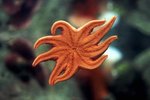
Animals referred to as worms include many unrelated slim, elongated and segmented species. Worms having bristles belong to taxonomic phylum Annelida, which hosts earthworms, bristle worms and Acanthobdellida, leechlike fish parasites. Worm bristles, or setae, help annelid worms propel through soil or water. Some annelids latch onto prey with their bristles. Evolving millions of years ago, annelids are globally dispersed.
Many Bristles or Few Bristles
Two types of bristled annelids exist. Polychaete annelids have many long, slender setae, sometimes called chaetae. Polychaete are the largest group of annelids. Clitellata annelids, including earthworms and some leeches, have fewer setae. Some worm bristles are long; others are short and hooked. They can be flowing or stiff and rodlike, depending on the species.
Nearly Invisible Bristles
An earthworms has 100 to 150 body segments, each having muscles and bristles. An earthworm's setae are so tiny, they're almost invisible. He uses them to anchor himself while navigating in soil, or when a bird is trying to pull him from the ground. The earthworm stretches out and holds onto the earth with his front bristles. He then contracts his body forward. Anchoring with his rear bristles, he stretches out again, propelling himself forward.
Sharp, Skin-Piercing Bristles
Polychaete annelids are free-living marine worms. Known as bristle worms, they can be 1 inch to 2 feet long. They have small appendages called parapodia protruding along their sides. Their setae, located on the parapodia tips, are rigid, rodlike and sharp enough to pierce skin. Polychaete annelids use their bristles to navigate among the substrate and living rocks they inhabit. Waving their parapodia and setae when swimming helps them propel through the water.
Forty Hooked Bristles
Acanthobdellida are leechlike, freshwater ectoparasites belonging to the phylum Annelida. They live in waters having insufficient plant life, attaching themselves to salmonoid fish with their dark brown, hooked setae. Blood and skin tissue from the host fish provide nourishment for them. Acanthobdellida peledina have 40 setae, each consisting of two bristles, located on their anterior sucker. Acanthobdellida usually attach to the base of the fish's dorsal fin, causing tissue damage, resulting in stress and infections.
References
- Phys.org: Scientists Use MicroRNAs to Track Evolutionary History for First Time
- University of Pennsylvania: Earthworms
- Backyard Nature: Earthworms
- Reefkeeping: Worms
- Reef Corner: Bristle Worm: Polychaetes
- U.S. National Library of Medicine: Leech-Like Parasites (Clitellata, Acanthobdellida) Infecting Native and Endemic Eastern Siberian Salmon Fishes
Photo Credits
-
Ryan McVay/Photodisc/Getty Images
Writer Bio
Karen Mihaylo has been a writer since 2009. She has been a professional dog groomer since 1982 and is certified in canine massage therapy. Mihaylo holds an associate degree in human services from Delaware Technical and Community College.



